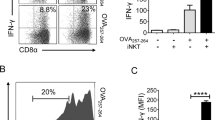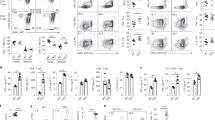Abstract
NKG2D is a receptor on natural killer (NK) cells and cytotoxic T lymphocytes that binds major histocompatibility complex (MHC) class I–like ligands expressed primarily on virally infected and neoplastic cells. In vitro studies indicate that NKG2D provides costimulation through an associated adapter, DAP10, which recruits phosphatidylinositol-3 kinase. Here we show that in DAP10-deficient mice, CD8+ T cells lack NKG2D expression and are incapable of mounting tumor-specific responses. However, DAP10-deficient NK cells express a functional NKG2D receptor due to the association of NKG2D with another adapter molecule, DAP12 (also known as KARAP), which recruits protein tyrosine kinases. Thus, NKG2D is a versatile receptor that, depending on the availability of adapter partners, mediates costimulation in T cells and/or activation in NK cells.
This is a preview of subscription content, access via your institution
Access options
Subscribe to this journal
Receive 12 print issues and online access
$209.00 per year
only $17.42 per issue
Buy this article
- Purchase on Springer Link
- Instant access to full article PDF
Prices may be subject to local taxes which are calculated during checkout







Similar content being viewed by others
References
Lanier, L.L. NK cell receptors. Annu. Rev. Immunol. 16, 359–393 (1998).
Bauer, S. et al. Activation of NK cells and T cells by NKG2D, a receptor for stress- inducible MICA. Science 285, 727–729 (1999).
Cerwenka, A. et al. Retinoic acid early inducible genes define a ligand family for the activating NKG2D receptor in mice. Immunity 12, 721–727 (2000).
Diefenbach, A., Jamieson, A.M., Liu, S.D., Shastri, N. & Raulet, D.H. Ligands for the murine NKG2D receptor: expression by tumor cells and activation of NK cells and macrophages. Nature Immunol. 1, 119–126 (2000).
Cosman, D. et al. ULBPs, novel MHC class I-related molecules, bind to CMV glycoprotein UL16 and stimulate NK cytotoxicity through the NKG2D receptor. Immunity 14, 123–133 (2001).
Sutherland, C.L. et al. UL16-binding proteins, novel MHC class I-related Proteins, bind to NKG2D and activate multiple signaling pathways in primary NK cells. J. Immunol. 168, 671–679 (2002).
Groh, V. et al. Cell stress-regulated human major histocompatibility complex class I gene expressed in gastrointestinal epithelium. Proc. Natl. Acad. Sci. USA 93, 12445–12450 (1996).
Groh, V., Steinle, A., Bauer, S. & Spies, T. Recognition of stress-induced MHC molecules by intestinal epithelial γδ T cells. Science 279, 1737–1740 (1998).
Diefenbach, A., Jensen, E.R., Jamieson, A.M. & Raulet, D.H. Rae1 and H60 ligands of the NKG2D receptor stimulate tumour immunity. Nature 413, 165–171 (2001).
Cerwenka, A., Baron, J.L. & Lanier, L.L. Ectopic expression of retinoic acid early inducible-1 gene (RAE-1) permits natural killer cell-mediated rejection of a MHC class I-bearing tumor in vivo. Proc. Natl. Acad. Sci. USA 98, 11521–11526 (2001).
Girardi, M. et al. Regulation of cutaneous malignancy by γδ T cells. Science 294, 605–609 (2001).
Groh, V. et al. Costimulation of CD8αβ T cells by NKG2D via engagement by MIC induced on virus-infected cells. Nature Immunol. 2, 255–260 (2001).
Wu, J. et al. An activating immunoreceptor complex formed by NKG2D and DAP10. Science 285, 730–732 (1999).
Lanier, L.L. & Bakker, A.B. The ITAM-bearing transmembrane adaptor DAP12 in lymphoid and myeloid cell function. Immunol. Today 21, 611–614 (2000).
Tomasello, E. et al. Gene structure, expression pattern, and biological activity of mouse killer cell activating receptor-associated protein (KARAP)/DAP-12. J. Biol. Chem. 273, 34115–34119 (1998).
McVicar, D.W. et al. DAP12-mediated signal transduction in natural killer cells. A dominant role for the Syk protein-tyrosine kinase. J. Biol. Chem. 273, 32934–32942 (1998).
Tomasello, E., Blery, M., Vely, E. & Vivier, E. Signaling pathways engaged by NK cell receptors: double concerto for activating receptors, inhibitory receptors and NK cells. Semin. Immunol. 12, 139–147 (2000).
Chang, C. et al. Cutting edge: KAP10, a novel transmembrane adapter protein genetically linked to DAP12 but with unique signaling properties. J. Immunol. 163, 4651–4654 (1999).
Wu, J., Cherwinski, H., Spies, T., Phillips, J.H. & Lanier, L.L. DAP10 and DAP12 form distinct, but functionally cooperative, receptor complexes in natural killer cells. J. Exp. Med. 192, 1059–1068 (2000).
Pages, F. et al. Binding of phosphatidylinositol-3-OH kinase to CD28 is required for T-cell signalling. Nature 369, 327–329 (1994).
Prasad, K.V. et al. T-cell antigen CD28 interacts with the lipid kinase phosphatidylinositol 3-kinase by a cytoplasmic Tyr(P)-Met-Xaa-Met motif. Proc. Natl. Acad. Sci. USA 91, 2834–2838 (1994).
Schwenk, F., Baron, U. & Rajewsky, K. A cre-transgenic mouse strain for the ubiquitous deletion of loxP-flanked gene segments including deletion in germ cells. Nucleic Acids Res. 23, 5080–5081 (1995).
Ho, E.L. et al. Costimulation of multiple NK cell activation receptors by NKG2D. J. Immunol. 169, 3667–3675 (2002).
Karre, K., Ljunggren, H.G., Piontek, G. & Kiessling, R. Selective rejection of H-2-deficient lymphoma variants suggests alternative immune defence strategy. Nature 319, 675–678 (1986).
Idris, A.H. et al. The natural killer gene complex genetic locus Chok encodes Ly-49D, a target recognition receptor that activates natural killing. Proc. Natl. Acad. Sci. USA 96, 6330–6335 (1999).
Wolpert, E.Z. et al. Generation of CD8+ T cells specific for transporter associated with antigen processing deficient cells. Proc. Natl. Acad. Sci. USA 94, 11496–11501 (1997).
Kelly, J.M., Takeda, K., Darcy, P.K., Yagita, H. & Smyth, M.J. A role for IFN-γ in primary and secondary immunity generated by NK cell-sensitive tumor-expressing CD80 in vivo. J. Immunol. 168, 4472–4479 (2002).
Kelly, J.M. et al. Induction of tumor-specific T cell memory by NK cell-mediated tumor rejection. Nature Immunol. 3, 83–90 (2002).
Roberts, A.I. et al. NKG2D receptors induced by IL-15 costimulate CD28-negative effector CTL in the tissue microenvironment. J. Immunol. 167, 5527–5530 (2001).
Diefenbach, A. et al. Selective associations with signaling proteins determine stimulatory versus costimulatory activity of NKG2D. Nature Immunol.; published online 11 November 2002 (doi:10.1038/ni858).
Long, E.O. Tumor cell recognition by natural killer cells. Semin. Cancer Biol. 12, 57–61 (2002).
Pende, D. et al. Role of NKG2D in tumor cell lysis mediated by human NK cells: cooperation with natural cytotoxicity receptors and capability of recognizing tumors of nonepithelial origin. Eur. J. Immunol. 31, 1076–1086 (2001).
Riegert, P. & Gilfillan, S. A conserved sequence block in the murine and human TCR Jα region: assessment of regulatory function in vivo. J. Immunol. 162, 3471–3480 (1999).
Acknowledgements
We thank K. Rajewsky for the Cre-transgenic mice, T. Miyazaki for the original vial of E14.1 cells, S. Kuschert for blastocyst injection, E. Wagner and colleagues for animal care at the former Basel Institute for Immunology and C. Strader for technical assistance. E. L. H. was supported by a training grant from the Cancer Research Institute and W. M. Y. was supported by NIH grants, the Barnes-Jewish Hospital Foundation and the Howard Hughes Medical Institute.
Author information
Authors and Affiliations
Corresponding author
Ethics declarations
Competing interests
The authors declare no competing financial interests.
Rights and permissions
About this article
Cite this article
Gilfillan, S., Ho, E., Cella, M. et al. NKG2D recruits two distinct adapters to trigger NK cell activation and costimulation. Nat Immunol 3, 1150–1155 (2002). https://doi.org/10.1038/ni857
Received:
Accepted:
Published:
Issue Date:
DOI: https://doi.org/10.1038/ni857
This article is cited by
-
The transcription factor Aiolos restrains the activation of intestinal intraepithelial lymphocytes
Nature Immunology (2024)
-
Second messenger 2'3'-cyclic GMP-AMP (2'3'-cGAMP): the cell autonomous and non-autonomous roles in cancer progression
Acta Pharmacologica Sinica (2024)
-
Mechanisms of the Effect of Simulated Microgravity on the Cytotoxicity of NK Cells Following the DNA Methylation of NKG2D and the Expression of DAP10
Microgravity Science and Technology (2021)
-
The NK cell–cancer cycle: advances and new challenges in NK cell–based immunotherapies
Nature Immunology (2020)
-
Natural killer group 2D receptor and its ligands in cancer immune escape
Molecular Cancer (2019)



